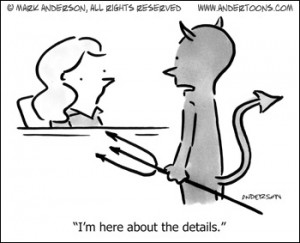[First posted in 2012. Halloween is a good time to learn everything there is to learn about the Prince of Darkness, the devil, yeah?After all, to him is attributed the creatures that resurrect if only in costume choices of fright-night enthusiasts.
So to save you the trouble of looking for the related articles, here’s a reading list to scare the hell out of you:
- So if there’s no devil and demonic spirits, explain the occult.
- If there’s no Devil, then there’s no hell?
- Does Judaism believe in heaven and hell?
- The Christian Devil Finally Goes to Christian Hell
- Ezekiel 28:1-19 is NOT about the Devil
- Isaiah 14:12-15 is not about the Devil
- Ha Satan in YHWH’s Heavenly Court?
- Is YHWH the source of evil?
- TNK” ha satan” vs. OT “Satan”/NT “Devil”
- So if there’s no devil and demonic spirits, explain the occult.
Just as light dispels darkness, God’s Truth is the best antidote to ignorance. Beware not the non-existent devil but be aware rather, of the evil inclination within each of us and allow the good inclination to dominate our heart, mind, and will. Happy halloween reading, spooks!—Admin1]
———————-
When we read any book translated from its original language, we should be aware that countless significant meanings are “lost in translation”. This is the most regrettable disadvantage of Bible students who can’t read Hebrew, Aramaic or Greek, the original languages of the Bible.
Look at all the versions/translations available in the bookstores, plus constant revisions to improve or update previous attempts. Surely it is not simply a case of financial gain that Bible translations are constantly updated; it must be that the laudable objective of providing the best, perfect, and the final cannot-further-be-improved-upon English translation is simply not possible. The better recourse for the reader is to learn the original languages, but who would embark on that except those who easily learn foreign languages besides bible scholars? Alas, for the rest of us, we are dependent on translators, and hope that translations are reliable and have no religious agenda toward a particular doctrinal position.
So how do problematic translations relate to the topic of this article? Ha Satan is just one of many examples of the problem with translations.
In Hebrew הַשָּׂטָן ha-Satan simply means “the opposer”, “the adversary”, “the challenger”; “ha” means “the”, and “satan” the three English synonyms or their equivalent.
Personification of this idea of a challenger could be imputed on any person, perhaps even God. In the Hebrew Bible where the idea is introduced, this challenger who proposes the alternative choice to any of God’s commands is represented in the serpent [to Adam and Eve], and the angel in God’s heavenly court who is given permission to test Job’s faithfulness to God, to give two examples.
How this idea gets blown up not only into a Satan/Devil/Lucifer/Fallen Angel/Head of Hell but elevated to an equal arch enemy of God — could partly be blamed on the problem with translations but perhaps more so on dogmatic agenda. It feeds on superstition, ancient pagan and false religions where demonic spirits are given prominence; and in dualism, the religious doctrine that presents the universe as controlled by opposing powerful forces of good and evil, one equal to the other.
In the Hebrew Bible, there is no power equal to Adonai Elohim YHWH! Everyone and everything in His created universe is subject to Him, and that of course includes the angelic hosts who are simply messengers sent on specific errands at His bidding. They do no more and no less than what their Creator specifies, just like robots!
Of all His created beings, only man has been given free will. None of the angels have been similarly endowed. If that is so, then how can one angel without free will make a choice to rebel against YHWH and consequently fall from grace? Only man is capable of that. And if there is no fallen angel who starts a rebellion against his Creator such that 1/3 of the angelic hosts join him [according to New Testament teaching], then where did the devil and demonic spirits originate? Are they simply figments of man’s imagination? How can that be, they are prominent in New Testament writings, from the gospels all the way to the book of Revelation.
As soon as Jesus is baptized and goes off to the desert before he even begins his ministry, who is the first figure he has to contend with? This is followed by many episodes of demonic oppression, possession, exorcisms — just in the gospels alone. The epistles continue the idea of the battle between good and evil, and how believers have to wear their spiritual armor for protection as well as for offense against the devil and his demons. Conferences on how to contend with spiritual powers take off from the writings of Paul who even names the heirarchy of evil spirits. And the book of Revelation is the culmination of this long drawn out battle through the ages, ending the reign of the “god of this world”, “the spirit of the air”. Ultimately, Satan and his ilk gets thrown down to hell where they belong.
This deluded world has conjured up a whole psychological justification for criminal acts that places the blame on everything else except personal responsibility. “The devil made me do it” . . . the devil is behind drug addiction, accidents, failed marriages, broken families, pedophilia and other sexual aberrations, etc. Man is helpless to overcome his fallen nature, his environment, the demonic forces that oppress him—“the world, the flesh, and the devil.”
The Hebrew Bible teaches the opposite. Man has free will; he is responsible for how he uses it, for good or for bad. There is no devil and no hell. Words like sheol, the abyss, the pit, are easily explainable when you understand their meaning in the literary context as well as the Hebrew language.
What about Isaiah 14:12-17 and Ezekiel 28? Here are posts explaining these misunderstood, misinterpreted and might we suggest, misapplied texts to justify the existence of an evil fallen angel who challenges and dares defy his Creator; geez, doesn’t he know his place? He’s like an ant challenging an elephant!
Check out the links recommended in this website and read the Jewish perspective; meanwhile, here’s another provocative thought: If there is no devil, is God the author of evil?




Reader Comments